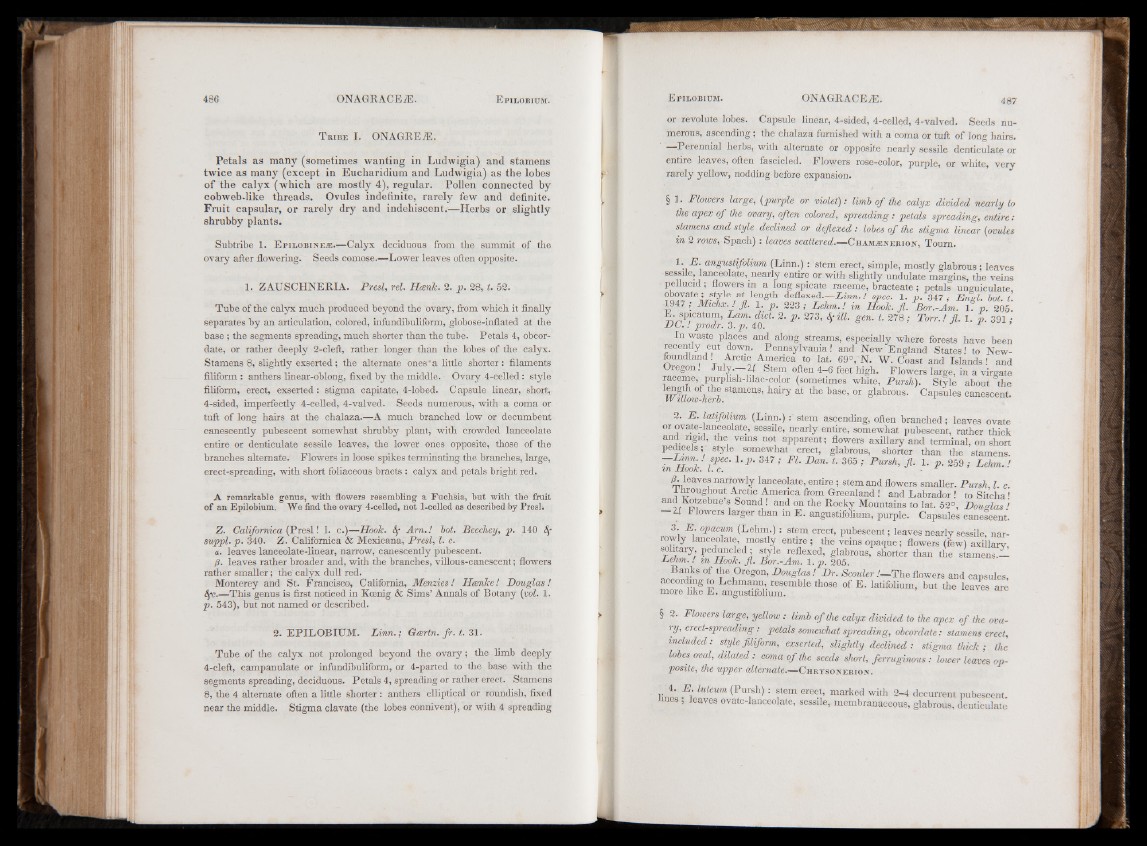
T r ib e I. ONAGREAL
Petals as many (sometimes wanting in Ludwigia) and stamens
twice as many (except in Eucharidium and Ludwigia) as the lobes
o f the calyx (which are mostly 4), regular. Pollen connected by
cobweb-like threads. Ovules indefinite, rarely few and definite.
Fruit capsular, or rarely dry and indehiscent.—Herbs or slightly
shrubby plants.
Subtribe 1. Epilobine®.—Calyx deciduous from the summit of the
ovary after flowering. Seeds comose.—Lower leaves often opposite.
1. ZAUSCHNERIA. Presl, rel. Hank. 2. p. 28, t. 52.
Tube of the calyx much produced beyond the ovary, from which it finally
separates by an articulation, colored, infundibuliform, globose-inflated at the
base ; the segments spreading, much shorter than the tube. Petals 4, obcor-
date, or rather deeply 2-cleft, rather longer than the lobes of the calyx.
Stamens 8, slightly exserted; the alternate ones'a little shorter: filaments
filiform : anthers linear-oblong, fixed by the middle. ■ Ovary 4-eelled: style
filiform, erect, exserted: stigma capitate, 4-lobed. Capsule linear, short,
4-sided, imperfectly 4-celled, 4-valved. Seeds numerous, with a coma or
tuft of long hairs at the chalaza.—A much branched low or decumbent
canescently pubescent somewhat shrubby plant, with crowded lanceolate
entire or denticulate sessile leaves, the lower ones opposite, those of the
branches alternate. Flowers in loose spikes terminating the branches, large,
erect-spreading, with short foliaceous bracts : calyx and petals bright red.
A remarkable genus, with flowers resembling a Fuchsia, but with the fruit
of an Epilobium. We find the ovary 4-celled, not 1-celled as described by Presl.
Z. Californica (Presl! 1. c.)—Hook. 8f A m .! hot. Beechey, p. 140 8f
svppl. p. 340. Z. Californica & Mexicana, Presl, l. c.
a. leaves lanceolate-linear, narrow, canescently pubescent.
0. leaves rather broader and, with the branches, villous-canescent; flowers
rather smaller; the calyx dull red.
Monterey and St. Francisco, California, Menzies! Hanke! Douglas!
Sfc.—This genus is first noticed in Kcenig & Sims’ Annals of Botany (vol. 1.
p. 543), hut not named or described.
2. EPILOBIUM. Linn.; Gartn. f r . t . 31.
Tube of the calyx not prolonged beyond the ovary; the limb deeply
4-cleft, campanulate or infundibuliform, or 4-parted to the base with the
segments spreading, deciduous. Petals 4, spreading or rather erect. Stamens
8, the 4 alternate often a little shorter : anthers elliptical or roundish, fixed
near the middle. Stigma clavate (the lobes eonnivent), or with 4 spreading
or revolute lobes. Capsule linear, 4-sided, 4-celled, 4-valved. Seeds numerous,
ascending ; the chalaza furnished with a coma or tuft of long hairs.
Perennial herbs, with alternate or opposite nearly sessile denticulate or
entire leaves, often fascicled. Flowers rose-color, purple, or white, very
rarely yellow, nodding before expansion.
§ 1. Flowers large, (purple or violet): limb of the calyx divided nearly to
the apex of the ovary, often colored, spreading: petals spreading, entire :
stamens and style declined or deflexed: lobes of the stigma linear (ovules
in 2 rows, Spach): leaves scattered.— C h a m ® n e r io n , Toum.
1. -E. angustifolium (Linn.): stem erect, simple, mostly glabrous; leaves
sessile, lanceolate, nearly entire or with slightly undulate margins, the veins
pellucid ; flowers m a long spicate raceme, bracteate ; petals unguiculate,
obovate; style at length deflexed.— Linn.! spec. 1 . p. 3 4 7 ; En el bot t
1947,; Michx. ! fl. 1. p. 223 ; Lehm.! in dook. f l.B o r .-A r Z l. p. 205
E. spicatum, Lam. diet. 2. p. 273, Sc ill. gen. t. 278; Torr.! fl. 1. p. 391 •
D C .! prodr. 3. p. 40. r ’
In waste places and along streams, especially where forests have been
recently cut down. Pennsylvania! and New England States! to Newfoundland!
Arctic America to lat. 69°,‘N. W. Coast and Islands! and
Oregon! July.— U Stem often 4-6 feet high. Flowers large, in a virgate
raceme, purplish-hlac-color (sometimes white, Pursh). Style about the
WtUowherb Stame:QS’ liairy at tlie base> or glabrous. Capsules canescent.
2. E . latifolium (Linn.): stem ascending, often branched; leaves ovate
or ovate-lanceolate, sessile, nearly entire, somewhat pubescent, rather thick
and rigid, the veins not apparent; flowers axillary and terminal, on short
pedicels;; style somewhat erect, glabrous, shorter than the stamens.
—Lmn. ! spec. 1. p. 347 ; Fl. Dan. t. 365 ; Pursh, fl. 1. p. 259 ; Lehm. '
m H ook. l.c . -
(i. leaves narrowly lanceolate, entire; stem and flowers smaller. Pursh, l. c
ihroughout Arctic America from Greenland ! and Labrador ! to Sitcha!
5 Sound ! and on the Rocky Mountains to lat. 52°, Douglas '
— U h lowers larger than in E. angustifolium, purple. Capsules canescent.
3. E . opacum (Lehm.): stem erect, pubescent; leaves nearly sessile, narrowly
lanceolate, mostly entire ; the veins opaque; flowers (few) axillary,
solitary, peduncled; style reflexed, glabrous, shorter than the stamens.—
Lehm. ! m Hook. fl. Bor.-Am. 1. p. 205.
Banks of the Oregon, Douglas ! Dr. Scouler .'—The flowers and capsules
mnrp^blrp F Lehmann, resemble those of E. latifolium, more like Hi. angustifolium. but the leaves are
§ 2. Flowers large, yellow : limb of the calyx divided to the apex of the wary,
erect-spreading: petals somewhat spreading, obcordate: stamens erect,
included: style filiform, exserted, slightly declined : stigma thick ; the
lobes oval, dilated : coma o f the seeds short, ferruginous: lower leaves opposite,
the upper alternate.—C h r y s o n e r io n .
linta E: luteUm (*>u? h) : f em erec> marked with 2-4 decurrent pubescent,
nes , leaves ovate-lanceolate, sessile, membranaceous, glabrous, denticulate